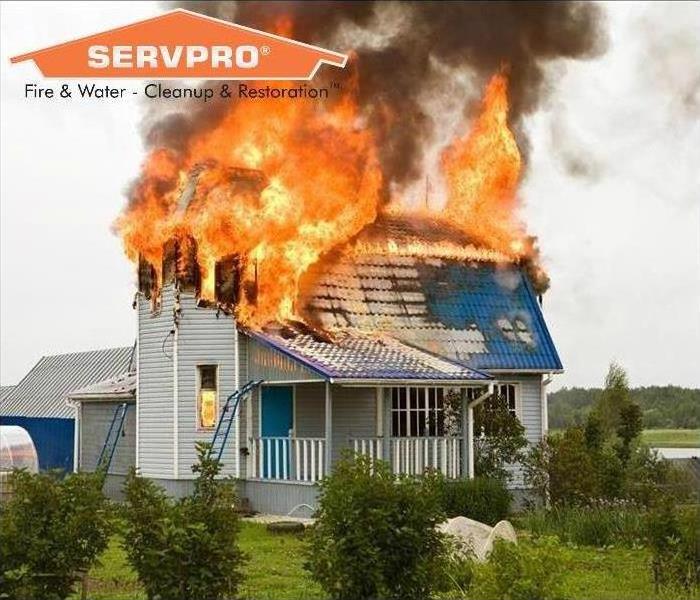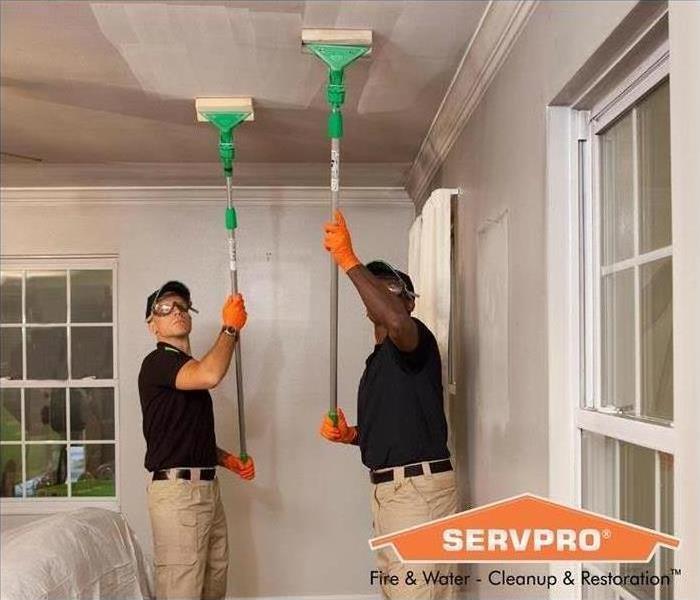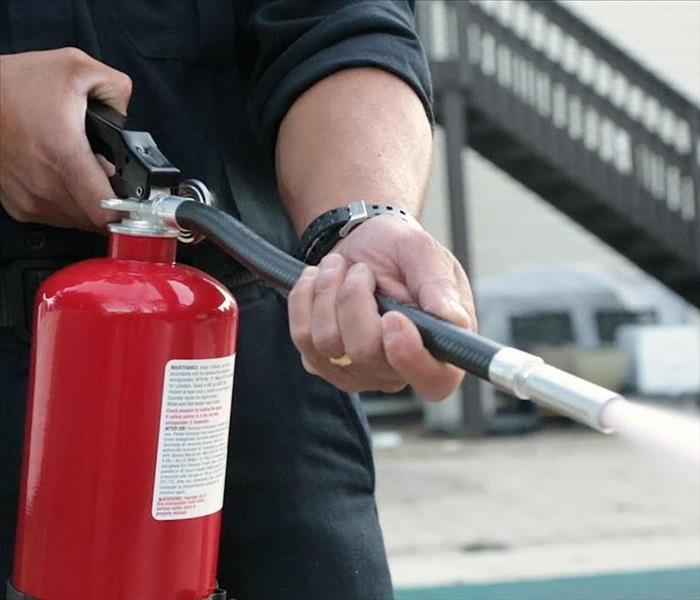Recent Fire Damage Posts
National Burn Awareness Week with SERVPRO® Team Spinner and the American Burn Association
2/9/2024 (Permalink)
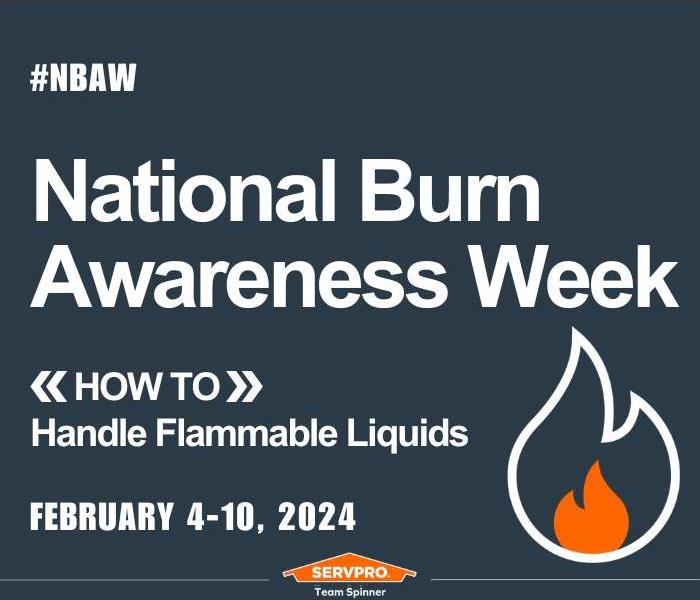 Always be mindful of how to handle flammable liquids!
Always be mindful of how to handle flammable liquids!
At SERVPRO® Team Spinner, we're committed to not only restoring properties but also promoting safety and well-being within our communities. With National Burn Awareness Week here, it's crucial to shed light on the importance of burn prevention and safety measures. Burns are not only painful injuries but can also lead to long-term physical and emotional trauma.
In this blog post, we'll explore the significance of National Burn Awareness Week and how SERVPRO Team Spinner is dedicated to spreading awareness and fostering a safer environment for all.
National Burn Awareness Week is hosted by the American Burn Association. This year's ABA theme is flammable liquids.
According to the National Fire Protection Association, Flammable and/or combustible liquids cause more than 51,000 home fire each year, resulting in 168 deaths, 1,029 injuries, and $644 million in property damage.
How do you handle flammable liquids? Handle with Care, Flammable Liquids Beware.
- Gasoline is an extremely flammable liquid and vapor with fumes capable of ignition up to 12 ft from a pooled source.
- All flammable liquid containers should be kept in cool, dry locations, and stored away from the home.
- Cooking oil is a highly flammable liquid. Keep your eyes on what you fry!
- Grills and gas ranges produce a lot of heat; keep your cooking area clear when around an open flame.
- Fuel lawnmowers, leaf blowers, and weed eaters when the engines are cool and in open area outdoors.
- Fuel snow blowers when the engines are cool and in an open area outdoors.
- Never use an accelerant such as gasoline, kerosene, or aerosol sprays to start a camp fire.
- When purchasing a gas can, be sure it has a fuel arrestor on the can to prevent flashback.
Stay tuned for additional valuable information and actionable steps to help ensure safety in your homes, workplaces, and communities.
Together, we can make a difference.
Lunar New Year Firework Caution: Ensuring a Safe Celebration
2/9/2024 (Permalink)
 It's the Year of the Dragon!
It's the Year of the Dragon!
Lunar New Year, also known as Chinese New Year or Spring Festival, is a time of vibrant festivities marked by colorful parades, delicious feasts, and joyous celebrations. Fireworks are an integral part of many Lunar New Year traditions, symbolizing the ushering in of good luck and prosperity. While fireworks add to the excitement of the occasion, it's essential to prioritize safety to prevent accidents and ensure a memorable celebration. In this blog post, we'll explore important Lunar New Year firework precautions with insights from SERVPRO® Team Spinner, a trusted leader in restoration and cleanup services.
Check Local Regulations: Before purchasing or using fireworks, familiarize yourself with local regulations and restrictions. Laws regarding fireworks vary from one area to another, and it's crucial to adhere to them to avoid fines or legal consequences. SERVPRO Team Spinner advises checking with your local authorities to ensure compliance with safety guidelines.
Choose a Safe Location: Select a suitable location for setting off fireworks, away from buildings, dry vegetation, and other flammable materials. We recommend using open, spacious areas such as parks or designated firework zones. Avoid firing fireworks in crowded or confined spaces to prevent accidents and injuries.
Keep Water Sources Handy: Have water sources such as buckets, hoses, or fire extinguishers readily available in case of emergencies. SERVPRO Team Spinner emphasizes the importance of being prepared to extinguish small fires or accidents quickly to prevent them from escalating.
Designate a Responsible Operator: Assign a responsible adult to handle and ignite the fireworks. This individual should be sober, knowledgeable about firework safety procedures, and capable of managing potential risks. We suggest ensuring that children and bystanders maintain a safe distance from the fireworks at all times.
Follow Instructions Carefully: Read and follow the manufacturer's instructions and safety guidelines provided with the fireworks. Use fireworks only as intended and avoid modifying or tampering with them in any way. We advise against attempting to relight malfunctioning fireworks and recommends disposing of them safely.
Protective Gear: Wear appropriate protective gear such as safety glasses and gloves when handling fireworks. We emphasize the importance of protecting your eyes, hands, and skin from potential sparks or debris during the firework display.
Dispose of Debris Properly: After the fireworks have been used, carefully collect and dispose of any debris or spent fireworks. We recommends soaking them in water before placing them in a designated trash container to prevent accidental fires.
As you celebrate Lunar New Year with fireworks and festivities, remember to prioritize safety for yourself, your loved ones, and your community. By following these firework precautions from SERVPRO Team Spinner, you can ensure a joyful and accident-free celebration. May the Year of the Dragon be filled with prosperity, happiness, and peace. Happy Lunar New Year!
Celebrate Safely: Firework Safety Tips for a Happy New Year
1/2/2024 (Permalink)
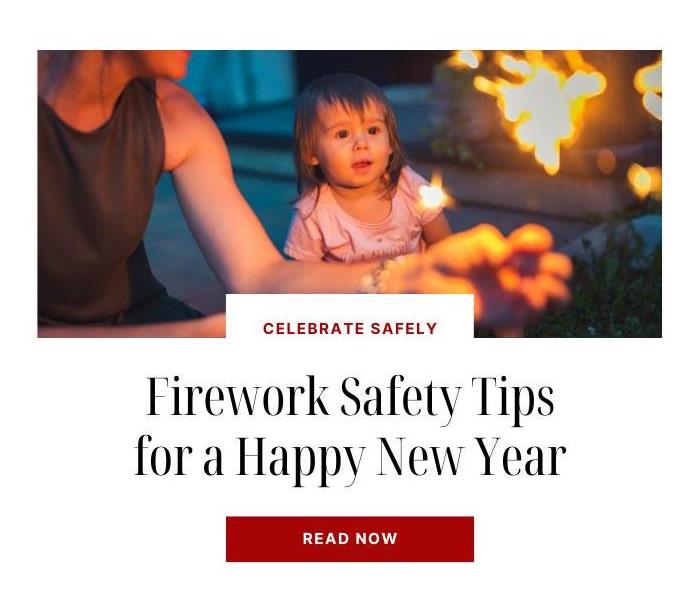 The New Year celebrations aren't over yet!
The New Year celebrations aren't over yet!
As we usher in the New Year with joy and excitement, it's essential to prioritize safety, especially when it comes to celebrating with fireworks at home. While fireworks add a dazzling touch to the festivities, mishandling them can lead to accidents and property damage. At SERVPRO® Team Spinner, we want you to have a memorable and safe New Year's celebration. In this blog post, we'll share essential firework safety tips to ensure your festivities are filled with joy and not unexpected emergencies.
Understanding the Risks:
Fireworks can pose significant risks when not handled with care. Common dangers include burns, injuries, and the potential for fires. Understanding these risks is the first step toward a safer celebration.
Legal and Safety Compliance:
Before planning a fireworks display, familiarize yourself with local laws and regulations regarding the use of fireworks. Ensure that the fireworks you choose comply with safety standards and are legally permissible in your area.
Selecting a Safe Location:
Open Space: Opt for a spacious, open area away from buildings, dry grass, and other flammable materials.
Avoid Crowded Areas: Steer clear of crowded places, and maintain a safe distance from spectators to prevent injuries.
Preparation and Planning:
Fire Extinguishers: Have a fire extinguisher and a bucket of water nearby as a precautionary measure.
Professional Displays: If possible, consider attending professional firework displays instead of setting off fireworks at home. These displays are conducted by trained experts in controlled environments.
Safe Handling Practices:
Adult Supervision: Never allow children to handle fireworks. Ensure that responsible adults are supervising the entire process.
Read Instructions: Carefully read and follow the instructions on each firework. Different fireworks have varying safety guidelines.
One at a Time: Ignite one firework at a time, and move away quickly after lighting.
No Alcohol: Avoid consuming alcohol while handling fireworks. Clear judgment is crucial for safety.
Post-Display Safety:
Dispose of Properly: Dispose of used fireworks by soaking them in water before placing them in a trash bin.
Check for Strays: After the display, check for any unexploded fireworks and properly dispose of them to prevent accidental ignition.
A safe and happy New Year's celebration is within reach with responsible firework practices. At SERVPRO Team Spinner, we wish you a joyous start to the New Year. By prioritizing safety, you can create lasting memories without compromising the well-being of yourself, your loved ones, or your property. Here's to a wonderful and safe New Year!
Kwanzaa Candle Lighting Caution: A SERVPRO® Guide to Safety
12/28/2023 (Permalink)
 Happy Kwanzaa from SERVPRO Team Spinner
Happy Kwanzaa from SERVPRO Team Spinner
Kwanzaa, a celebration of African heritage and culture, is marked by various rituals, one of which is the lighting of the Kinara. This symbolic candle holder represents the seven principles of Kwanzaa, known as the Nguzo Saba. While the lighting of the candles is a beautiful and significant part of the festivities, safety should always be a top priority. In this blog post, we'll explore essential Kwanzaa candle lighting precautions with insights from SERVPRO Team Spinner, a leading restoration and cleanup service.
Secure Placement: When placing the Kinara, ensure it is on a stable, non-flammable surface. SERVPRO Team Spinner recommends placing it away from curtains, tablecloths, or any other combustible materials. A secure placement minimizes the risk of accidental fires and enhances the safety of your Kwanzaa celebration.
Supervision and Responsibility: Never leave a lit Kinara unattended. Whether using traditional candles or modern electric lights, maintaining supervision ensures a swift response to any unforeseen incidents. SERVPRO Team Spinner emphasizes the importance of responsible candle management to prevent potential fire damage during the Kwanzaa celebration.
Keep a Clear Radius: Create a clear radius around the Kinara to prevent any accidental knockovers. Especially in households with children or pets, a little extra caution can go a long way in avoiding accidents. SERVPRO Team Spinner recommends securing the Kinara in place to minimize the risk of it being accidentally bumped or tipped.
Candle Selection: Choose candles that fit securely in the Kinara's candle holders. Loose or improperly sized candles can tilt, increasing the risk of fire. SERVPRO Team Spinner suggests using high-quality, dripless candles to reduce mess and minimize the likelihood of a fire spreading.
Keep Flammable Items Away: During the candle lighting ceremony, remove any flammable materials from the immediate vicinity of the Kinara. SERVPRO Team Spinner advises against placing paper, napkins, or any easily combustible items near the candles to avoid accidental ignition.
Emergency Preparedness: Accidents can happen even with the utmost caution. SERVPRO Team Spinner suggests having a fire extinguisher nearby and ensuring that everyone in the household is familiar with its operation. Knowing emergency exit routes and having a plan in place to evacuate the premises safely is also crucial.
Regular Maintenance: Before each use, inspect the Kinara for any signs of wear or damage. SERVPRO Team Spinner recommends cleaning the candle holders regularly to remove any wax buildup, reducing the risk of flare-ups during candle lighting.
As you celebrate Kwanzaa with family and friends, remember that safety should always be a top priority. By following these Kwanzaa candle lighting precautions from SERVPRO Team Spinner, you can ensure a festive and secure holiday season. May your Kwanzaa be filled with unity, creativity, and the glow of safely lit candles.
Safety First: Why Frying Turkey Can Pose Thanksgiving Hazards
11/15/2023 (Permalink)
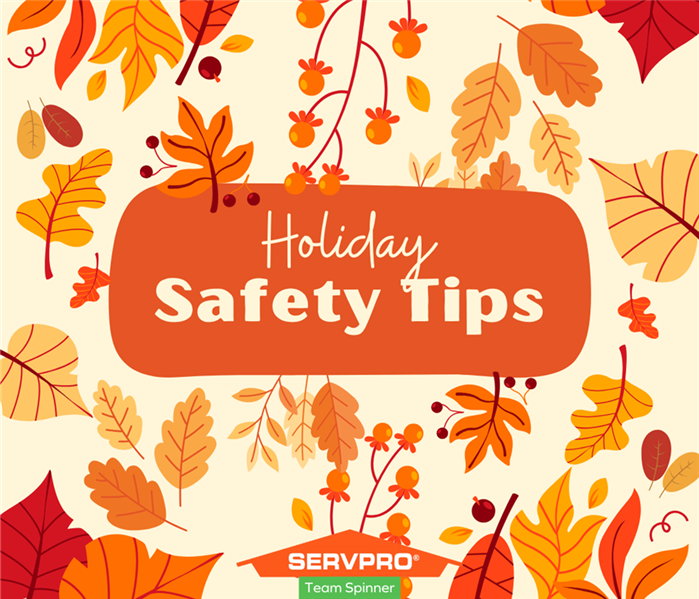 Holiday Safety Tips from SERVPRO Team Spinner
Holiday Safety Tips from SERVPRO Team Spinner
Thanksgiving is a time for family, gratitude, and of course, delicious food. While many embrace the tradition of roasting a turkey in the oven, the trend of deep-frying turkeys has gained popularity in recent years. At SERVPRO Team Spinner, our commitment to community safety prompts us to shed light on the potential hazards associated with deep-frying turkeys and to encourage a Thanksgiving celebration that prioritizes safety.
Risks of Deep-Frying Turkey:
Fire Hazard: Deep-frying a turkey involves immersing it in hot oil, creating a potential fire hazard. The oil can overheat, leading to a dangerous situation. According to the National Fire Protection Association (NFPA), turkey fryers are responsible for numerous fires each year, causing significant damage to homes and properties.
Hot Oil Burns: Handling hot oil poses a serious risk of burns and injuries. The process of lowering a turkey into boiling oil requires caution and precision. Accidents can happen when individuals are not familiar with the proper safety measures or when equipment is not used correctly.
Lack of Experience: Deep-frying a turkey requires a certain level of expertise and experience. Individuals attempting it for the first time may underestimate the potential dangers involved, leading to accidents that could have been avoided with proper knowledge and preparation.
SERVPRO Team Spinner's Safety Tips:
Choose Safety Over Speed: While deep-frying may offer a quicker cooking time, it's essential to prioritize safety. Consider alternative cooking methods that eliminate the risk of hot oil and open flames.
Maintain a Safe Distance: If you choose to fry your turkey, ensure the fryer is set up a safe distance from structures, including your home. An outdoor, flat, and stable surface is crucial to prevent accidents.
Thaw the Turkey Completely: Thoroughly thaw the turkey before frying to prevent oil splatters and reduce the risk of fire. Ice or water on an unfrozen turkey can cause the hot oil to bubble and splatter.
Never Leave Unattended: Supervise the turkey fryer at all times. Leaving it unattended increases the risk of accidents and potential disasters.
At SERVPRO Team Spinner, we prioritize the safety and well-being of our community. As you prepare for Thanksgiving, consider the potential risks associated with deep-frying a turkey. Opt for safer cooking methods to ensure a joyous and incident-free holiday celebration. Let's make this Thanksgiving a time of gratitude and happiness, without compromising the safety of our loved ones and homes.
Shine Bright, Stay Safe: Diwali Fire Caution from SERVPRO Team Spinner
11/14/2023 (Permalink)
 Happy Diwali from SERVPRO Team Spinner!
Happy Diwali from SERVPRO Team Spinner!
Diwali, a joyous festival of lights, was on Monday, November 13. Unfortunately, during this festive holiday, a fire is not an uncommon occurrence.
The team at SERVPRO wants to share some important fire safety precautions to ensure your celebrations remain bright and safe for next year or for anyone celebrating later this week.
Diwali is a time for family, friends, and beautiful decorations, but it's crucial to be mindful of potential fire hazards. Here are some tips to keep your Diwali festivities safe and enjoyable:
Inspect Electrical Decorations: Before decking out your home with colorful lights and electronic decorations, carefully inspect each item for frayed wires, damaged sockets, or any signs of wear. Replace any damaged items to prevent electrical fires.
Avoid Overloading Outlets: Distribute your electrical load evenly and avoid overloading outlets. Plugging too many devices into a single outlet can lead to overheating and increase the risk of a fire.
Use LED Lights: Opt for LED lights over traditional incandescent ones. LED lights produce less heat, reducing the risk of fire. Additionally, they are more energy-efficient and have a longer lifespan.
Keep Flames in Check: If you include traditional diyas or candles in your celebrations, ensure they are placed in stable holders and are kept away from flammable materials. Never leave lit candles unattended.
Maintain Safe Distances: Keep decorations, including curtains, drapes, and other combustible items, away from heat sources and open flames. Maintain a safe distance to prevent accidental fires.
Supervise Fireworks Displays: If fireworks are a part of your Diwali tradition, exercise caution and follow local safety guidelines. Ensure that fireworks are lit in open areas, away from buildings and dry vegetation.
Keep Fire Safety Equipment Handy: Have fire extinguishers and smoke detectors in strategic locations within your home. Regularly check and maintain these devices to ensure they are in good working condition.
Create an Emergency Plan: In the event of a fire, have a well-thought-out emergency plan in place. Ensure that all family members are aware of the evacuation routes and meeting points.
Dispose of Ashes Safely: If you use fire pits or burn incense during Diwali, ensure that ashes are fully extinguished before disposal. Dispose of ashes in a metal container, away from combustible materials.
Stay Informed: Keep yourself informed about local fire safety regulations and guidelines. Understanding and following these regulations is crucial to ensuring a safe and enjoyable Diwali.
At SERVPRO Team Spinner, your safety is our priority. We wish you a Happy and Safe Diwali filled with light, laughter, and moments of joy. Shine on, and let's celebrate responsibly!
Protecting Your Home: Fall Fire Safety & Holiday Season Fire Prevention
10/2/2023 (Permalink)
As the leaves change colors and the air turns crisp, autumn ushers in a season of warmth, family gatherings, and festive celebrations. However, it's also a time when fire risks can increase, and it's crucial to keep your home and loved ones safe. At SERVPRO of Western Essex County, we are dedicated to promoting fire safety year-round. In this blog post, we'll discuss essential tips for autumn fire safety and how to prevent fire incidents during the holiday season.
Fall Fire Safety:
1. Heating Safety:
With temperatures dropping, many homeowners rely on heating systems to keep warm. Ensure your heating equipment, whether it's a furnace, fireplace, or space heater, is in good working condition. Have them inspected and cleaned regularly to prevent potential fire hazards.
2. Chimney Maintenance:
If you have a wood-burning fireplace, autumn is an ideal time for chimney maintenance. Clear any debris or nests from your chimney, and check for creosote buildup, a highly flammable substance that can ignite and lead to a chimney fire.
3. Smoke Alarms and Carbon Monoxide Detectors:
Test your smoke alarms and carbon monoxide detectors to make sure they're functioning correctly. Replace batteries if needed, and consider installing interconnected alarms to provide early warning in case of a fire.
4. Dryer Vent Cleaning:
Dryer vents can accumulate lint over time, increasing the risk of a fire. Regularly clean your dryer vent and check for any blockages.
Holiday Season Fire Prevention:
1. Safe Decorating:
During the holiday season, homes are adorned with festive decorations. Be cautious with candles, string lights, and other decorations near flammable materials. Never leave candles unattended, and use flameless candles as a safer alternative.
2. Cooking Safety:
Holiday feasts are a tradition for many families. Stay attentive when cooking, and keep flammable items, such as dish towels and oven mitts, away from the stovetop. Use a timer to remind you when dishes are ready to avoid distractions.
3. Christmas Tree Safety:
If you have a live Christmas tree, keep it well-watered to prevent it from becoming a fire hazard. Ensure that string lights are in good condition and do not overload electrical outlets.
4. Fire Escape Plan:
Discuss and practice a fire escape plan with your family. Make sure everyone knows how to exit the house safely in case of an emergency. Designate a meeting point outside the home.
Conclusion:
SERVPRO of Western Essex County is committed to helping you keep your home safe during the autumn season and throughout the holidays. By following these fire safety tips, you can enjoy the beauty and warmth of the season without worrying about potential fire risks. Remember that prevention is key, but in the event of a fire emergency, our team is here to help restore your home to its pre-fire condition. Stay safe and have a joyful autumn and holiday season!
Have Questions about Fire, Smoke, or Soot Damage?
Call Us Today – (908) 650-8611
What to do After a Fire
11/3/2022 (Permalink)
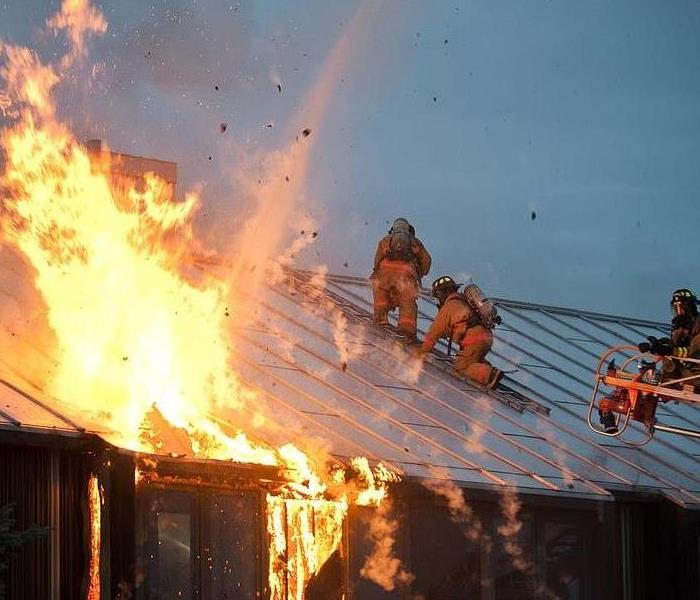 You may not know what to do after a fire. Follow these steps to get a little clarity and call us if you need help.
You may not know what to do after a fire. Follow these steps to get a little clarity and call us if you need help.
Now that the fire is out, there are a few things you need to know. Here is a check list to follow:
Step 1 - Securing the site
- Protect the fire site from any further damage by weather, theft or vandalism. Do not leave the site unsecured.
- If you are the owner it is your responsibility to see that openings are covered against rain and entry. Make sure outside doors to the property can be locked and secured. The Fire Department will help secure the premises until responsibility can be handed over to the tenant or insurance company.
- If you are the tenant contact your real estate agent or landlord and inform them of the fire. If you cannot contact them and you need professional assistance in boarding the premises, a general contractor for or fire damage restoration firm can help. Check your telephone directory.
- If you plan to leave the site, try to remove any valuable remaining in the building.
- Contact your own insurance agent to report the loss.
Step 2- Cautions
- Household wiring which may have been water damaged should be checked by a licensed electrician before power is turned back on.
- Check for structural damage caused by the fire. Roofs and floors may be weakened. The local Council's Building Inspector may be able to help.
- Food, drink and medicines exposed to heat, smoke or soot may be discarded in the appropriate manner.
- Refrigerators and freezers left unopened will hold their temperature for a short time. However do not attempt to refreeze thawed items.
- The Fire Department will call for the services of the local gas, fuel and electricity suppliers to disconnect services before they leave the site.
- If a utility (gas, electricity or water) is disconnected, it is your responsibility to have the services checked and reconnected by a licensed trade person. Do not attempt to reconnect the service yourself.
- Start collecting receipts for any money you spend. These are important because you can use them to show the insurance company what money you have spent relating to your fire loss and also verifying losses claimed.
Step 3 - Insurance Claims
- Make personal contact with the insurance claims manager.
- Advise the claims manager of loss or damage and give him, or her, a forwarding address and telephone number if the circumstances have forced you to leave the damaged fire building.
- The sooner the insurance company is alerted, the quicker the insurance claim can be processed, as the company has to alert the insurance adjuster to carry out the inspection.
- Try to form an inventory, as soon as possible, of household items either inside or outside the buildings which have been damaged by fire. The inventory of damaged items will further speed the claim when the loss adjuster makes contact. Do not throw away any damaged goods until after the inventory is made by the insurance adjuster.
Step 4 - Leaving your home
- If you have to leave your home because the fire has left it unsafe, contact the local police. They can keep an eye on the property in your absence.
- Check with your insurance company to find out whether you are entitled to stay in hotel as part of a temporary housing clause in your policy, or how soon you might get an advance on your eventual insurance claim settlement.
- Provided it is safe to do so, try to locate the following to take with you:
- Identification
- Vital medicines, such as blood pressure regulating drugs or insulin.
- Eyeglasses, hearing aids, prosthetic devices or personal aids.
- Valuables such as credit cards, check-books, insurance policies, savings account books, money and jewelry.
Notify these people of your new address
- Your employer.
- Family and friends.
- Your children's schools.
- Your Post Office. Have them either hold or forward your mail, depending on the length of time you expect to be relocated.
- Delivery services like newspapers and milk.
- Telecom and the suppliers of gas, electricity and water.
contact:
SERVPRO of Western Essex County at 973-994-1640
We will help to get your life in order after this catastrophic event.
Business Safety
11/3/2022 (Permalink)
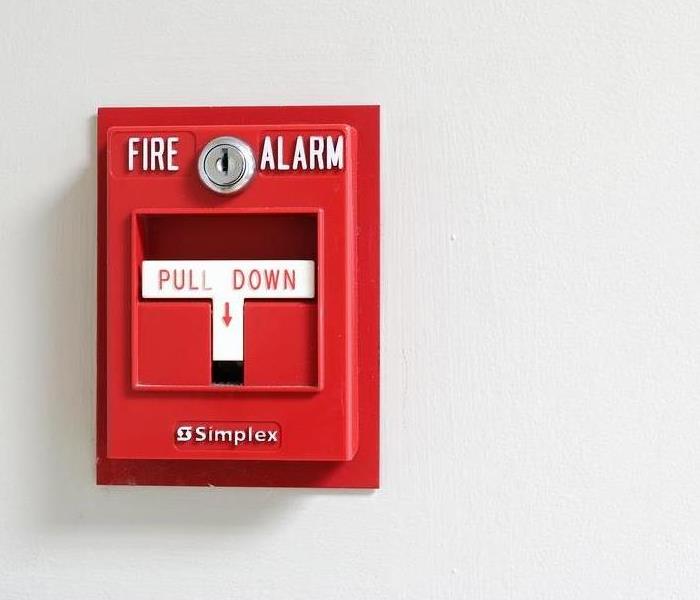 Talk to your staff about fire safety today.
Talk to your staff about fire safety today.
Fire Safety Tips for the Workplace
No matter type of business you conduct at your workplace, fire safety should always be a main concern. Here are a few fire safety tips you can distribute to your staff.
Fire Prevention
- Keep your work area free of waste paper, trash and other items that can easily catch fire.
- Check on your electrical cords. If a cord is damaged in any way, replace it. Try not to lay cords in places where they can be stepped on, as this will contribute to deterioration of the protective outside coating.
- Don't overload your circuits.
- Turn off electrical appliances at the end of each day.
- Keep heat producing equipment away from anything that might burn. This includes copiers, coffee makers, computers, etc.
In the Event of a Fire
- Upon finding a fire, call 911 immediately and don't hand up with the emergency responder until told to do so.
- Close doors when exiting to help limit the spread of smoke and fire throughout the building.
- Never use elevators during an evacuation.
- Follow the escape plan and meet at a per-determined place outside of your building and away from danger. Conduct a headcount to ensure all of your staff has evacuated.
The best way to ensure the safety of your staff is through fire prevention and preparation. Talk with your staff about fire safety in the workplace today.
How to Help Prevent House Fires
11/3/2022 (Permalink)
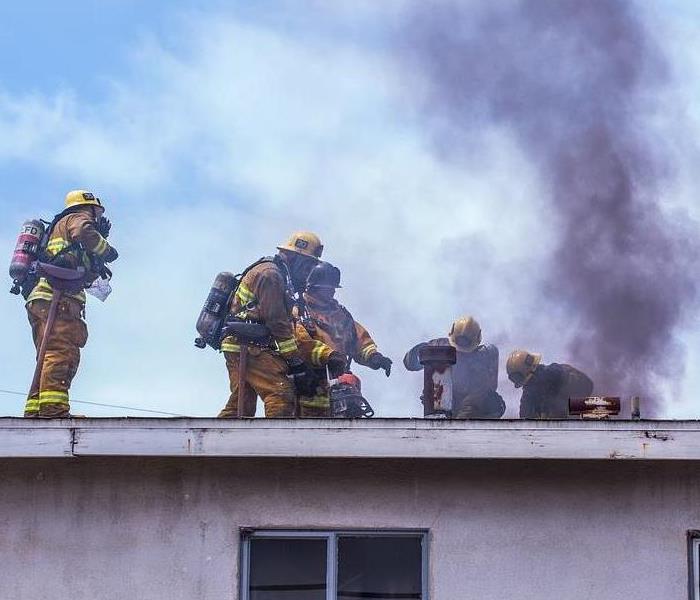 Follow these tips to help prevent a house fire.
Follow these tips to help prevent a house fire.
We have developed a list of the most common causes of fire-related losses as well as some things you can do to help prevent them.
Faulty Wiring and Outlets Are One of the Top Causes of House Fires.
- Check the electrical cords throughout your home for signs of fraying, and replace all frayed wires.
- Do not pinch or cover electrical cords with items such as rugs.
- Be aware of the capacity of your home's electrical system. Do not overload your circuits. If you have questions about your home's electrical system, you may want to consult a licensed electrician.
- Understand the difference between surge protectors and power strips—both allow you to plug in multiple electronic devices, but only the surge protector will help protect these devices from a power spike. Use surge protectors to protect valuable electronic devices, such as computers and televisions.
Carelessness in the Kitchen May Also Lead to a House Fire.
- Never leave your pots or pans unattended on your stove.
- Keep a kitchen fire extinguisher readily available and know how to use it.
- Keep your stove and oven clean. Built up food splatter or grease can later ignite when the stove or oven is turned on for cooking.
Clothes Dryers Are Another Common Source of House Fires.
- If you are installing your own dryer vent, follow the directions in the manufacturer’s installation instructions, using the recommended duct material. If you are unsure about how to properly install the vent, consider hiring a professional to do the installation.
- Clean out the dryer vent regularly.
- Clean out the lint filter after each load.
- Lint may also collect under and behind your dryer, so do not forget to clean these areas.
Alternative Heating Sources May Also Create a Fire Hazard.
- Avoid using an older space heater, as it may not have adequate safety features compared to newer units. When purchasing a new space heater, ensure it is UL Listed and pay attention to the safety features.
- Do not place a space heater near furniture, curtains or other objects that could easily catch fire.
- If you plan to install an alternative heating system, such as a wood or pellet stove, follow the manufacturer's instructions. If you are unsure about how to properly install the system, consider hiring a professional to do the installation.
- Before installing a wood or pellet stove, check to ensure it complies with the laws of your state and municipality.
Dirty Chimneys Also Pose a Fire Hazard.
- Have your chimney inspected annually by a Chimney Safety Institute of America (CSIA)-certified chimney sweep. Have a professional clean and repair the chimney as needed, especially before the cold months, when you will be using it frequently.
- Use seasoned wood only. Never burn green or damp wood.
- Never burn cardboard boxes, wrapping paper, trash or trees in your fireplace—these can all spark chimney fires.
Can You Identify Common Fire Hazards in Your Home? | SERVPRO® of Western Essex County
3/14/2022 (Permalink)
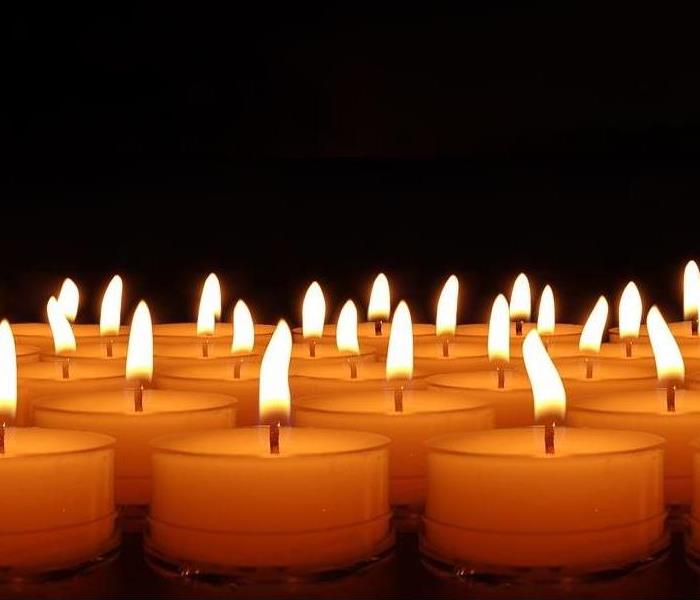 A quick response from SERVPRO of Western Essex County ensures your Damage Restoration needs are professionally completed.
A quick response from SERVPRO of Western Essex County ensures your Damage Restoration needs are professionally completed.
Nobody wants to think about the possibility of their home being damaged by fire, but it’s an unfortunate, harsh reality for a multitude of Americans.
One way you can help protect your home is to understand fire hazards and know how to identify them. In this blog, let’s dive into two of the most common causes of household fires.
Candles are a common fire hazard.According to the National Fire Protection Association, over a five-year period from 2011 to 2015, fire departments across the United States answered an estimated 8,700 house fires a year that were caused by candles.
In total, these fires caused 82 deaths, 800 injuries and $295 million in property damage. Candles were the cause of 2 percent of reported house fires, of which 3 percent resulted in death and 7 percent resulted in injuries.
An average of 24 home candle fires per day were reported during those five years, with December having the highest month of incidents. Out of all the candle fires during this time period, 37 percent started in the bedroom and were responsible for 36 percent of the associated deaths and 51 percent were associated with injuries.
When using a candle, be sure it’s kept at least one foot away from anything that could possibly ignite and that it is in a sturdy holder that will not easily tip over. It is never wise to use a candle where oxygen is in use in a home. And you always want to ensure that all candles are properly extinguished before leaving a room or going to sleep.
House fires from smoking can be lethal.While cooking is the leading cause of house fires, smoking is the main cause of home fire deaths. Approximately 17,200 house fires were reported in 2014 due to smoking, which includes cigarettes, pipes and cigars. Those fires resulted in 570 deaths, 1,140 injuries and $426 million in property damage, according to the Coalition for Fire-Safe Cigarettes.
If you’re a smoker, it is smart to smoke outside, as most deaths result from fires that started in living rooms, family rooms or bedrooms. Fire-safe cigarettes are the best option, and using a deep, sturdy ashtray is advised.
Drop all lit cigarettes and ashes in water or sand prior to throwing them out—and remember that one out of four fatal victims of smoking fires is not the smoker whose cigarette started the fire.
Dust bunnies as fire hazards?While candles and smoking are well-known causes of home structure fires, were you aware that some glassware in your home could be a fire risk? When sunlight passes through them, the concentrated ray may ignite flammable materials. It’s best to keep glass accessories away from windows and out of direct sunlight.
Dust bunnies can also pose a fire risk when they collect near electrical sockets and floor heaters. Regular sweeping or vacuuming regularly and cleaning hard-to-reach areas like behind entertainment systems can help prevent buildup.
Also, look for loose outlets in your home. The movement of these outlets loosens the wires connected to the outlet and could create dangerous arcing.
Fire and smoke damage can be devastating to homes, and in many circumstances, can be accompanied by water damage from firefighting efforts. If your home is damaged by fire or smoke, SERVPRO® of Western Essex County is here to help restore your home to pre-fire condition.
How To Protect Your Home From A Fire When Your Electricity Comes Back On | SERVPRO Western Essex County
3/11/2022 (Permalink)
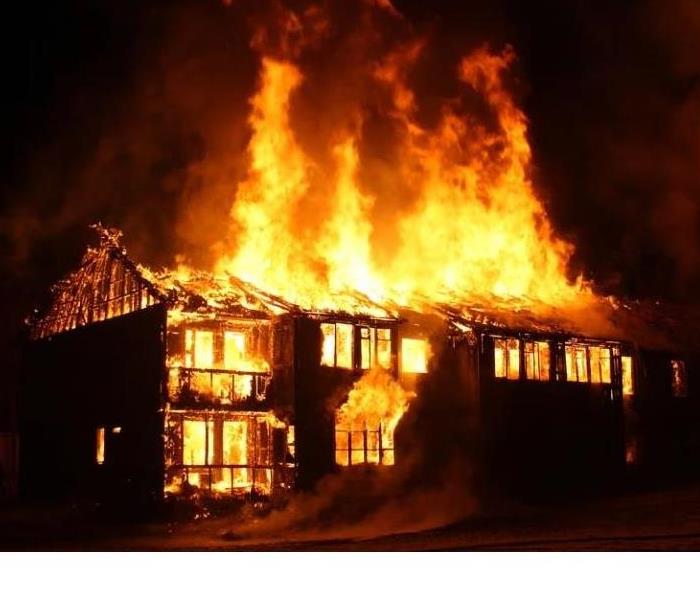 A quick response time with an alertful team will ensure that your restoration needs are professionally completed by SERVPRO of Western Essex County.
A quick response time with an alertful team will ensure that your restoration needs are professionally completed by SERVPRO of Western Essex County.
Did you know that when your power comes back on, the initial surge can cause damages to your appliances or possibly a fire if they are still plugged in.
In the United States, it is reported that a home fire is put on record every 24 seconds according the NFPA. That works out to be nearly 8,600 house fires a day.
Though the vast majority of house fires are cooking related, surges, malfunctioning appliances and frayed wires or cords are also often to blame. Because fire can spread rapidly and can quickly consume an entire house, it is essential to be vigilant in prevention for the safety of your household (even during a disaster).
Prevention Tips When The Power Goes Out
- Walk around an unplug bigger power users, television, computers, appliances, and turn off smaller ones like lamps and radios.
- Turn off the main supply of power to the house or remove the fuses.
- During summer months, turn the air conditioner off.
By following these tips, you can mitigate the risk of frying your electronics or overloading your house’s circuits.
When The Power Comes Back On
Once the power returns, wait a few minutes before turning on the main supply switch.To give the electrical system a chance to stabilize, turn on essential appliances first, then gradually turn on other electronics.
Restarting appliances all at once can almost double the amount of electricity that they use when running normally. When the main switches are re-energized, this demand can cause breakers to trip. It helps if you don't have all your appliances waiting to draw power the instant it is restored.
Fire and smoke damage can be devastating to your home, and in many circumstances, can be accompanied by water damage. If your home is damaged by fire or smoke, we are here to help restore your home to pre-fire condition. Contact us at 908.650.8611.
We are available for cleanup and restoration services 24 hours a day, seven days a week.
How to Prevent House Fires | SERVPRO® of Western Essex County
2/16/2022 (Permalink)
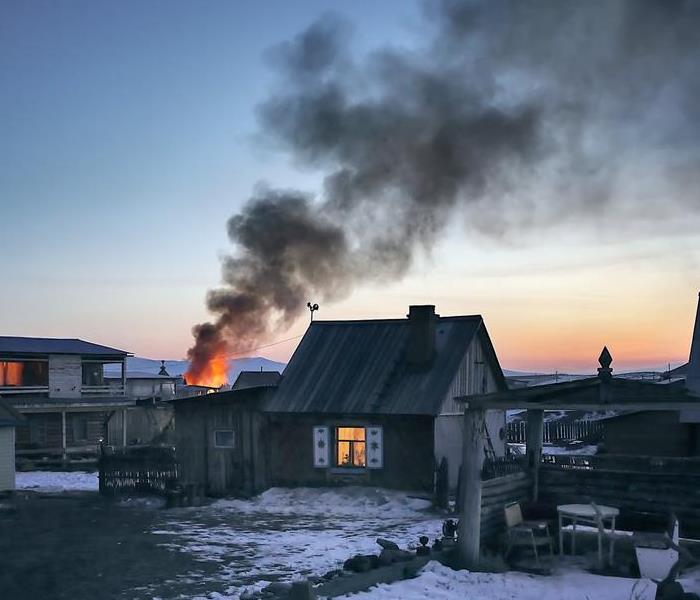 A quick response time with an alertful team will ensure that your restoration needs are professionally completed by SERVPRO of Western Essex County.
A quick response time with an alertful team will ensure that your restoration needs are professionally completed by SERVPRO of Western Essex County.
Smoke alarms are a great tool for house fire prevention, but they are not the only way to lessen your risk.
The causality of house fires is varied, but one thing that is consistent is how frequently they occur. By learning about the statistics and proven prevention methods, homeowners can keep their families safe.
The Numbers Behind House FiresIn the United States, it is reported that a home fire is put on record every 24 seconds according to the NFPA. That works out to nearly 8,600 house fires a day.
Though the vast majority of house fires are cooking-related, malfunctioning appliances, frayed wiring or cords, and carelessness with open flames are also often to blame. Because fires spread rapidly and can quickly consume an entire home, it is essential to be vigilant in prevention for the safety of your household.
House Fires Prevention TipsBeing proactive is the best defense against house fires. By keeping these fire prevention tips in mind, you can minimize your risk and keep your home safer:
Maintain smoke detectors. Maintain your smoke detectors by testing them each month and replacing them every 10 years.
Clean the dryer. After each load of laundry is dried, make a point to clear lint from the tray. Lint can build up and become a fire hazard when the dryer gets warm.
Keep an eye on open flames. Fires can start and spread faster than you think, which is why it is never wise to leave the room when there is an open flame. Whether it is a candle, cooking flame or fireplace, always keep an eye on them.
Maintain electrical cords. Cords and electrical wires should be checked often for frayed spots and immediately replaced if they are present. Never run electrical cords under rugs or behind furniture, as they can produce heat.
Read product labels. Chemicals in household products can be highly flammable, and so can products that come in aerosol cans. Keep these away from sunlight or heat sources.
If your home has suffered damage from a house fire, give us a call. We are certified in fire and soot remediation, and here to help 24⁄7.
Fire Safety Basics to Help Protect Your Family | SERVPRO® of Western Essex County
11/19/2021 (Permalink)
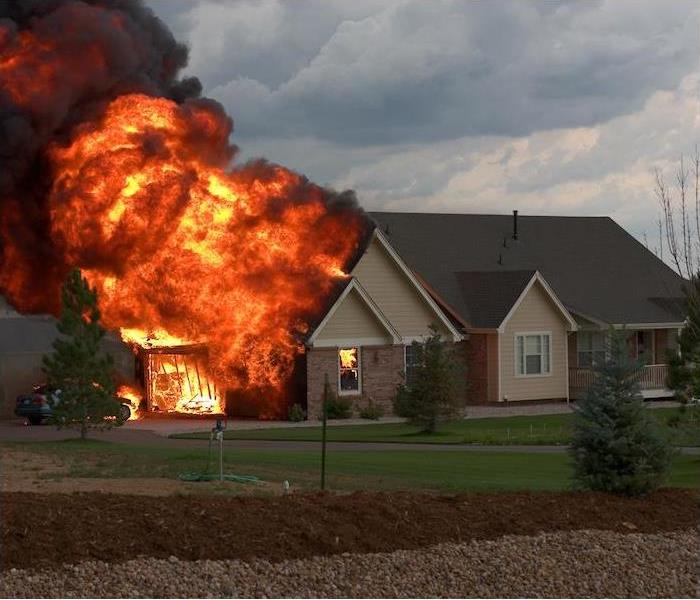 A quick response time with an alertful team will ensure that your restoration needs are professionally completed by SERVPRO of Western Essex County.
A quick response time with an alertful team will ensure that your restoration needs are professionally completed by SERVPRO of Western Essex County.
Every year in the United States, more than 350,000 house fires happen, adding up to more than $5.5 billion in property damage. Beyond the financial loss, these fires also lead to nearly 3,000 deaths and another 10,000 injuries.
The best defense for your family against a fire is to prepare in advance. That’s why it’s important for every person to know how to prevent fires and how to respond if one occurs.
Start teaching your kids basic fire safety guidelines when they’re young. Let’s also take a look at three other fire safety practices you can practice as a family:
Watch Out for Fire Hazards
Go through your home. You might be surprised how many fire hazards you spot! Take some time and go through every room and your outdoor space to uncover any hazards.
- Ensure your appliances are in good shape.
- Check that electrical cords are in workable condition.
- Do not overload outlets and/or extension cords.
- Check to make sure you are using the correct wattage of lightbulbs.
- Double-check that electrical wiring is not covered up by rugs or carpet.
Creating Your Fire Plan
In the event of a fire, every person in the family needs to know what to do—including how to get out of the house and where to go once they’re out.
But don’t just create a plan and not have practice drills. After all, as the saying goes, “practice makes perfect.” Regular practice of what to do makes you more likely to remember the steps if an actual fire occurs.
Practice Kitchen Fire Safety
Cooking is the biggest single cause of home fires. That’s why it’s important to be especially careful in the kitchen.
Anyone who’s cooking needs to familiarize themselves with basic cooking safety:
- Never cook when tired or unable to pay attention.
- Do not leave kids and teens alone when they cook.
- Always keep a lid at hand when cooking on the stove in case of a grease fire. If a small grease fire occurs, use the lid to smother the fire.
- If a fire occurs in the oven, turn it off and keep the door closed.
- Leave the room and close the door if a kitchen fire occurs and begins to spread.
How to Prevent House Fires | SERVPRO® of Western Essex County
11/15/2021 (Permalink)
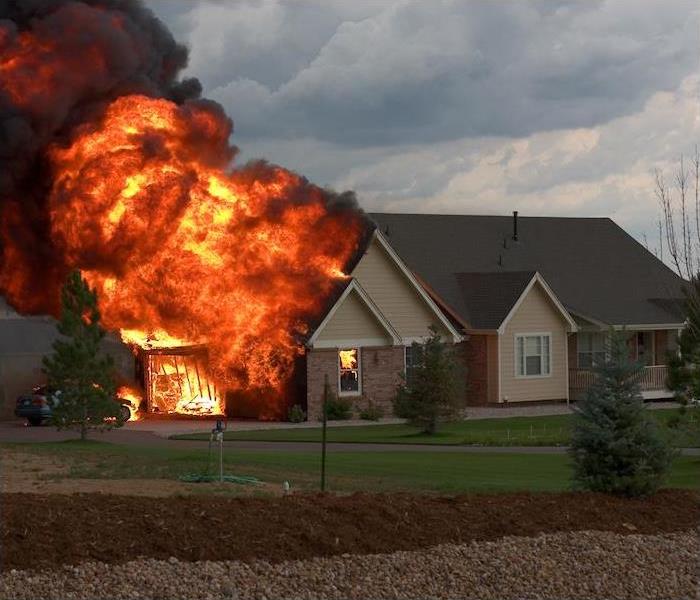 If your home has suffered damage from a house fire, give us a call. We are certified in fire and soot remediation, and here to help 24/7.
If your home has suffered damage from a house fire, give us a call. We are certified in fire and soot remediation, and here to help 24/7.
Smoke alarms are a great tool for house fire prevention, but they are not the only way to lessen your risk.
The causality of house fires is varied, but one thing that is consistent is how frequently they occur. By learning about the statistics and proven prevention methods, homeowners can keep their families safe.
The Numbers Behind House Fires
In the United States, it is reported that a home fire is put on record every 24 seconds according to the NFPA. That works out to nearly 8,600 house fires a day.
Though the vast majority of house fires are cooking-related, malfunctioning appliances, frayed wiring or cords, and carelessness with open flames are also often to blame. Because fires spread rapidly and can quickly consume an entire home, it is essential to be vigilant in prevention for the safety of your household.
House Fires Prevention Tips
Being proactive is the best defense against house fires. By keeping these fire prevention tips in mind, you can minimize your risk and keep your home safer:
Maintain smoke detectors. Maintain your smoke detectors by testing them each month and replacing them every 10 years.
Clean the dryer. After each load of laundry is dried, make a point to clear lint from the tray. Lint can build up and become a fire hazard when the dryer gets warm.
Keep an eye on open flames. Fires can start and spread faster than you think, which is why it is never wise to leave the room when there is an open flame. Whether it is a candle, cooking flame or fireplace, always keep an eye on them.
Maintain electrical cords. Cords and electrical wires should be checked often for frayed spots and immediately replaced if they are present. Never run electrical cords under rugs or behind furniture, as they can produce heat.
Read product labels. Chemicals in household products can be highly flammable, and so can products that come in aerosol cans. Keep these away from sunlight or heat sources.
Avoiding Fire Hazards While Cooking | SERVPRO® of Western Essex County
11/15/2021 (Permalink)
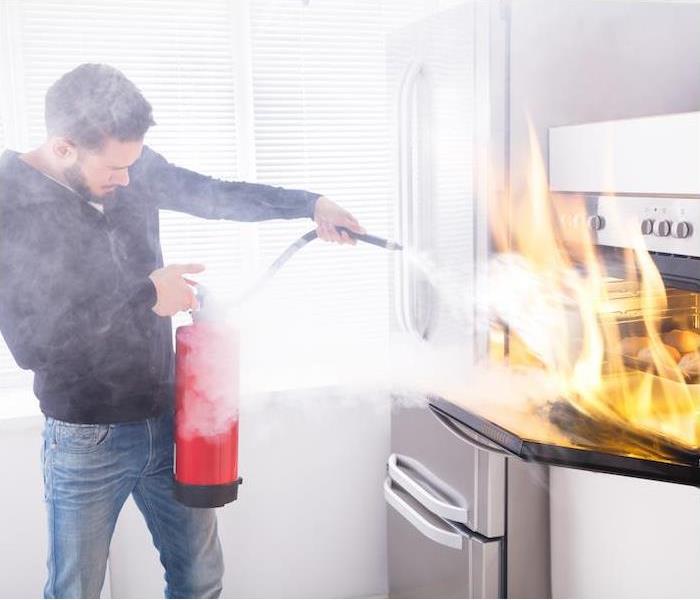 If your home has experienced damage from a cooking fire, know that SERVPRO® of Western Essex County is here to make it “Like it never even happened.”
If your home has experienced damage from a cooking fire, know that SERVPRO® of Western Essex County is here to make it “Like it never even happened.”
Even though the kitchen can be a wonderfully versatile place for family and friends to gather to enjoy a fresh-cooked meal or to spend quality time together, danger can lurk. Unfortunately, home fires can often begin in the kitchen.
Fires resulting from cooking are the No. 1 cause of home fires and injuries and, often, the leading cause of these kitchen fires is unattended cooking.
Over $130 million in homeowners insurance claims that were related to grease and other cooking fires were paid out in 2017 by State Farm Insurance. According to the insurance company, these are the worst states for kitchen fires:
- North Carolina
- Texas
- Pennsylvania
- California
- Ohio
- Illinois
- Maryland
- New York
- Alabama
- Georgia
Staying Safe in the KitchenThere are other safety tips to look into, as well as the well-known tip of remaining in the kitchen while cooking. Here are some other helpful tips to observe while cooking:
1. Be careful of your clothing. If you are wearing long, flowing sleeves or loose fitting clothing, it is best to change into a short or close-fitting sleeved shirt or make sure any loose shirts are tucked in or tied back away from the stove. Loose clothing could catch fire if you aren’t careful and get too close while cooking over the stove.
2. Be aware of what you are placing on or near the stovetop. Make sure there are no kitchen towels, oven mitts, appliance cords or even curtains too close to the stovetop when cooking. Ideally, it is best to move anything flammable away from the stove.
3. Place a fire extinguisher in or close to the kitchen. It is best to have at least one fire extinguisher located in your home and, ideally, one that is near your kitchen. Make sure you know how to properly use the extinguisher, just in case it is ever needed.
4. Wait before throwing hot grease in the garbage can. Even if the grease may not be on fire, it could still be hot enough to cause something in the trash to burn. Letting the grease cool a bit and then disposing of it in an old coffee can is safest. Also, know the smoke points of the oils you cook with. Be sure to never subject a low-smoke point oil to high heat when cooking, as it could catch fire.
5. Be sure there is a fire escape plan established. Thinking about the worst that can happen is not fun, but it’s better if you are over-prepared rather than unprepared if an emergency were to occur. Go over exit routes and designated meeting points with your family, making sure that everyone knows what to do.
Fire safety in the kitchen is an absolute necessity, as it can help prevent dangerous and destructive cooking fires.
Learn More About Our “Restore First” Mentality
3/19/2021 (Permalink)
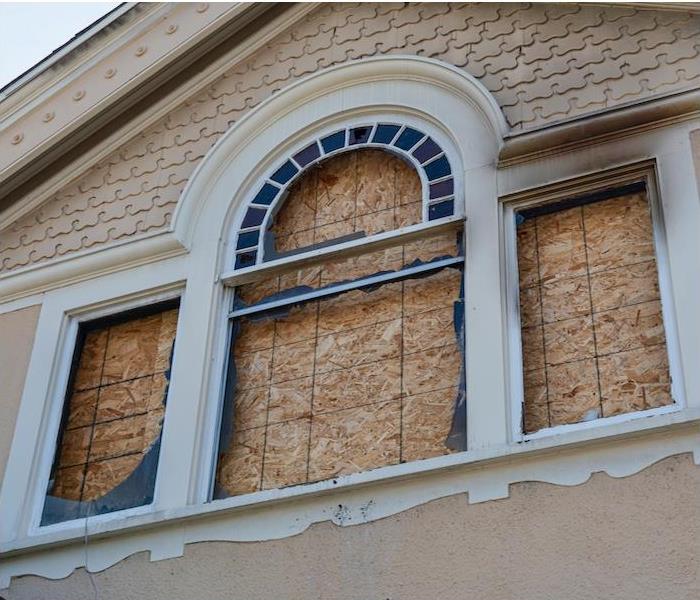 Our team of highly trained restoration experts are available for emergency cleanup and restoration services 24 hours a day, seven days a week.
Our team of highly trained restoration experts are available for emergency cleanup and restoration services 24 hours a day, seven days a week.
When disaster strikes, we get there fast, but that is not the only reason why we need to be first on your list of calls if the worst should occur.
What sets us apart—our team of technicians have a “restore first” mentality, complemented by specialized equipment and cleaning techniques. By making this our mission, we are able to minimize potential disruptions to your home and life and get you back into your home as quickly as feasible.
How It Works
When a fire has damaged your property, it’s a scary time, but once you reach out to our team, we’ll take some of the weight off your shoulders.
No two fires act the same, so it’s logical that the damage they inflict would also be different. That’s why we believe in starting with a standardized process, but adding onto it and enhancing it to meet your individual needs.
1. You call us. When you reach out via our 24⁄7 Emergency Line, we will spring into action. Our first step is to ask you questions about the fire and your home’s unique space and needs. That set of questions helps inform our strategy.
2. We inspect and assess the fire damage. Our next step is to visit your home. During this visit, we will inspect and test adjoining rooms of the property to determine the extent of fire, smoke and soot damage. Based on what we see and determine, we will take immediate next steps.
3. We board up windows and tarp the roof. Because fire damage often compromises windows, walls and roofs, we will make sure that your property is secured and protected from further damage. This will involve boarding up missing windows and walls and placing a tarp over the top of damaged roofs.
4. We remove water and begin the drying out process. When we think of fire, we don’t think of water damage. But we should, because water is a necessary component of fighting fires. So our next step is to remove any standing water and start drying out objects and spaces when possible.
5. We remove smoke and soot from all surfaces. We use specialized equipment and techniques to remove smoke and soot from ceilings, walls and other surfaces in your home.
6. We clean and sanitize your home. This is another place where the “restore first” mentality comes into play. We will attempt to clean objects and surfaces whenever possible, rather than removing and replacing them. We also use industrial air scrubbers and fogging equipment to help remove odors.
7. We complete the restoration. This is our final step, bringing your property back to the condition it was in before the fire. Restoration may involve minor repairs like replacing drywall, painting and installing new carpet. It could also involve major repairs like reconstruction of damaged areas.
Remember, if you need us, we’ll be there—no matter the time or day. Our team of highly trained restoration experts are available for emergency cleanup and restoration services 24 hours a day, seven days a week.
The Right Restoration Company Makes a Difference
3/11/2021 (Permalink)
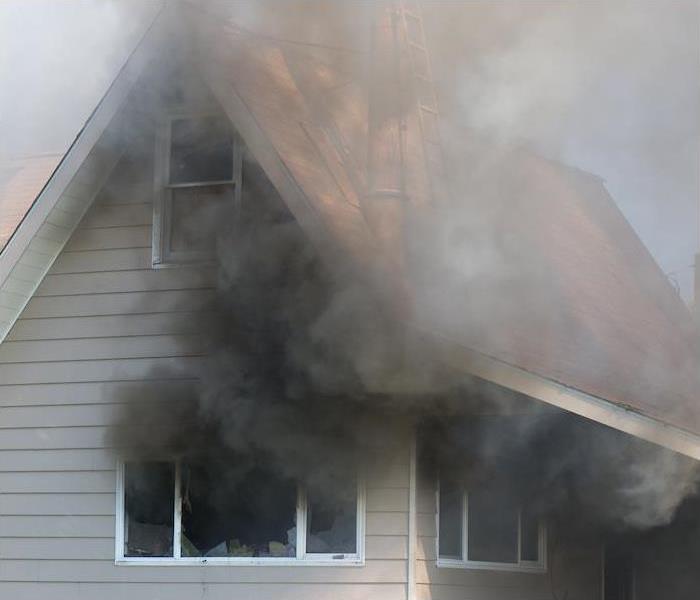 When disaster strikes, we strike back! Contact us at 908.650.8611 for 24/7 emergency service.
When disaster strikes, we strike back! Contact us at 908.650.8611 for 24/7 emergency service.
While planning ahead for house fires might seem dismal, it is a wise choice for homeowners. You should create a fire evacuation plan for your household, and also consider the restoration company you will work with to restore your home if it’s ever needed. Picking a company that can respond quickly and restores thoroughly is highly recommended.
Restoring Your Home and Belongings After a FireFire damages are multifaceted—not only can they affect the structure of your home, but they can also damage your things and be detrimental to air quality. Finding a company that can handle all these aspects is vital to having the proper restoration completed. Here is how we restore after a fire:
Structural Cleaning
It is important that the structure of your home is prepared quickly and well following a house fire because these are the elements that support your home. We will start with tests to get an overview of the damage severity so we know what repairs should be completed. By using industry-grade equipment, we will then begin to remove soot and damage from surfaces.
Content Cleaning
Because we know how important your belongings are, we make sure our technicians are able to restore most items as well. Wood and upholstered furniture can be cleaned and deodorized thoroughly. Oftentimes, we are also able to restore paintings, photos and electronics as well by utilizing appropriate tools and methods to protect them.
Deodorization Services
The smoke smell after a fire can linger for ages, but that is not the only concern. Fires can leave soot particles behind that cause serious health concerns with exposure as well. That is why instead of trying to mask the scent, we use air scrubbers to fully purify and deodorize the air. Our technicians will work with you to develop the best deodorization method for your needs in order to provide your family with healthy air once more.
If you’ve been affected by a fire, reach out to us right away! We are here 24⁄7 to help you recover.
Fire Safety Basics to Help Protect Your Family | SERVPRO® of Western Essex County
1/20/2021 (Permalink)
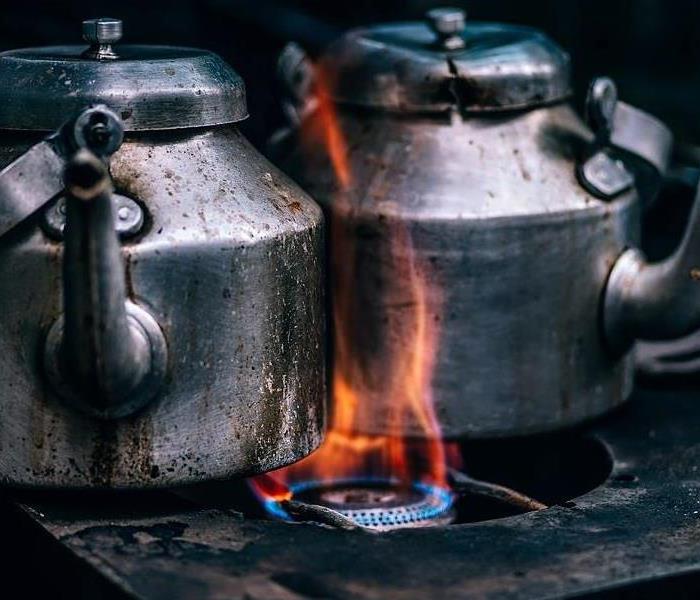 If your family has experienced a fire and needs help restoring your home, we can help!
If your family has experienced a fire and needs help restoring your home, we can help!
Every year in the United States, more than 350,000 house fires happen, adding up to more than $5.5 billion in property damage. Beyond the financial loss, these fires also lead to nearly 3,000 deaths and another 10,000 injuries.
The best defense for your family against a fire is to prepare in advance. That’s why it’s important for every person to know how to prevent fires and how to respond if one occurs.
Start teaching your kids basic fire safety guidelines when they’re young. Let’s also take a look at three other fire safety practices you can practice as a family:
Watch Out for Fire Hazards
Go through your home. You might be surprised how many fire hazards you spot! Take some time and go through every room and your outdoor space to uncover any hazards.
- Ensure your appliances are in good shape.
- Check that electrical cords are in workable condition.
- Do not overload outlets and/or extension cords.
- Check to make sure you are using the correct wattage of lightbulbs.
- Double-check that electrical wiring is not covered up by rugs or carpet.
Creating Your Fire Plan
In the event of a fire, every person in the family needs to know what to do—including how to get out of the house and where to go once they’re out.
But don’t just create a plan and not have practice drills. After all, as the saying goes, “practice makes perfect.” Regular practice of what to do makes you more likely to remember the steps if an actual fire occurs.
Practice Kitchen Fire Safety
Cooking is the biggest single cause of home fires. That’s why it’s important to be especially careful in the kitchen.
Anyone who’s cooking needs to familiarize themselves with basic cooking safety:
- Never cook when tired or unable to pay attention.
- Do not leave kids and teens alone when they cook.
- Always keep a lid at hand when cooking on the stove in case of a grease fire. If a small grease fire occurs, use the lid to smother the fire.
- If a fire occurs in the oven, turn it off and keep the door closed.
- Leave the room and close the door if a kitchen fire occurs and begins to spread.
Avoiding Fire Hazards While Cooking | SERVPRO of Western Essex County
11/19/2020 (Permalink)
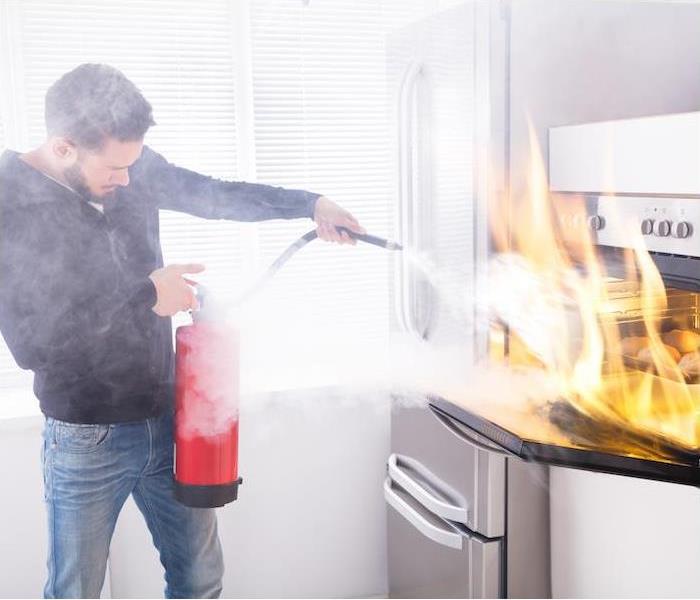 A quick response time with an alertful team will ensure that your restoration needs are professionally completed.
A quick response time with an alertful team will ensure that your restoration needs are professionally completed.
Even though the kitchen can be a wonderfully versatile place for family and friends to gather to enjoy a fresh-cooked meal or to spend quality time together, danger can lurk. Unfortunately, home fires can often begin in the kitchen.
Fires resulting from cooking are the No. 1 cause of home fires and injuries and, often, the leading cause of these kitchen fires is unattended cooking.
Over $130 million in homeowners insurance claims that were related to grease and other cooking fires were paid out in 2017 by State Farm Insurance. According to the insurance company, these are the worst states for kitchen fires:
- North Carolina
- Texas
- Pennsylvania
- California
- Ohio
- Illinois
- Maryland
- New York
- Alabama
- Georgia
Staying Safe in the Kitchen
There are other safety tips to look into, as well as the well-known tip of remaining in the kitchen while cooking. Here are some other helpful tips to observe while cooking:
1. Be careful of your clothing. If you are wearing long, flowing sleeves or loose fitting clothing, it is best to change into a short or close-fitting sleeved shirt or make sure any loose shirts are tucked in or tied back away from the stove. Loose clothing could catch fire if you aren’t careful and get too close while cooking over the stove.
2. Be aware of what you are placing on or near the stovetop. Make sure there are no kitchen towels, oven mitts, appliance cords or even curtains too close to the stovetop when cooking. Ideally, it is best to move anything flammable away from the stove.
3. Place a fire extinguisher in or close to the kitchen. It is best to have at least one fire extinguisher located in your home and, ideally, one that is near your kitchen. Make sure you know how to properly use the extinguisher, just in case it is ever needed.
4. Wait before throwing hot grease in the garbage can. Even if the grease may not be on fire, it could still be hot enough to cause something in the trash to burn. Letting the grease cool a bit and then disposing of it in an old coffee can is safest. Also, know the smoke points of the oils you cook with. Be sure to never subject a low-smoke point oil to high heat when cooking, as it could catch fire.
5. Be sure there is a fire escape plan established. Thinking about the worst that can happen is not fun, but it’s better if you are over-prepared rather than unprepared if an emergency were to occur. Go over exit routes and designated meeting points with your family, making sure that everyone knows what to do.
Fire safety in the kitchen is an absolute necessity, as it can help prevent dangerous and destructive cooking fires. If your home has experienced damage from a cooking fire, know that SERVPRO of Western Essex County is here to make it “Like it never even happened.”
The Right Restoration Company Makes a Difference | SERVPRO of Western Essex County
11/11/2020 (Permalink)
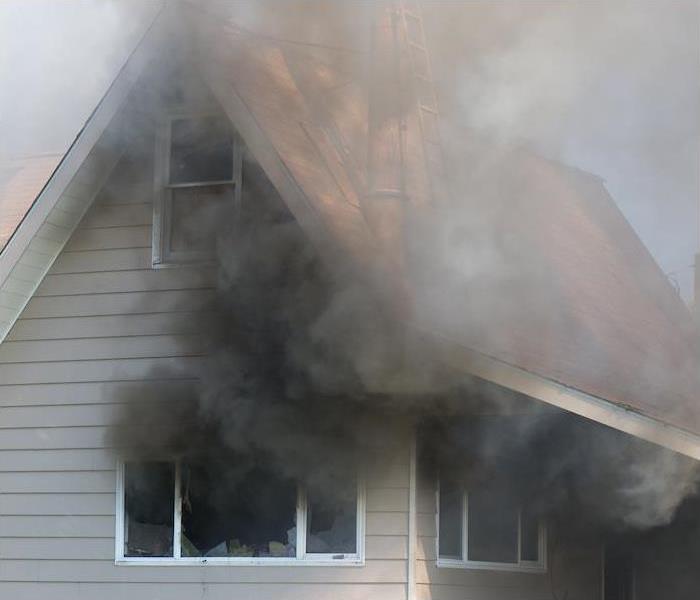 Having a team on your side after a disaster can help relieve stress. We are here to help when a fire strikes.
Having a team on your side after a disaster can help relieve stress. We are here to help when a fire strikes.
Winter has many positive associations, including increased time with family and exciting holidays. However, the Red Cross notes that winter has the highest volume of house fires as well, urging families to be prepared.
While planning ahead for house fires might seem dismal, it is a wise choice for homeowners. You should create a fire evacuation plan for your household, and also consider the restoration company you will work with to restore your home if it’s ever needed. Picking a company that can respond quickly and restores thoroughly is highly recommended.
Restoring Your Home and Belongings After a Fire
Fire damages are multifaceted—not only can they affect the structure of your home, but they can also damage your things and be detrimental to air quality. Finding a company that can handle all these aspects is vital to having the proper restoration completed. Here is how we restore after a fire:
Structural Cleaning
It is important that the structure of your home is prepared quickly and well following a house fire because these are the elements that support your home. We will start with tests to get an overview of the damage severity so we know what repairs should be completed. By using industry-grade equipment, we will then begin to remove soot and damage from surfaces.
Content Cleaning
Because we know how important your belongings are, we make sure our technicians are able to restore most items as well. Wood and upholstered furniture can be cleaned and deodorized thoroughly. Oftentimes, we are also able to restore paintings, photos and electronics as well by utilizing appropriate tools and methods to protect them.
Deodorization Services
The smoke smell after a fire can linger for ages, but that is not the only concern. Fires can leave soot particles behind that cause serious health concerns with exposure as well. That is why instead of trying to mask the scent, we use air scrubbers to fully purify and deodorize the air. Our technicians will work with you to develop the best deodorization method for your needs in order to provide your family with healthy air once more.
If you’ve been affected by a fire, reach out to us right away! We are here 24⁄7 to help you recover.
Fire Safety Basics to Help Protect Your Family | SERVPRO® of Western Essex County
11/6/2020 (Permalink)
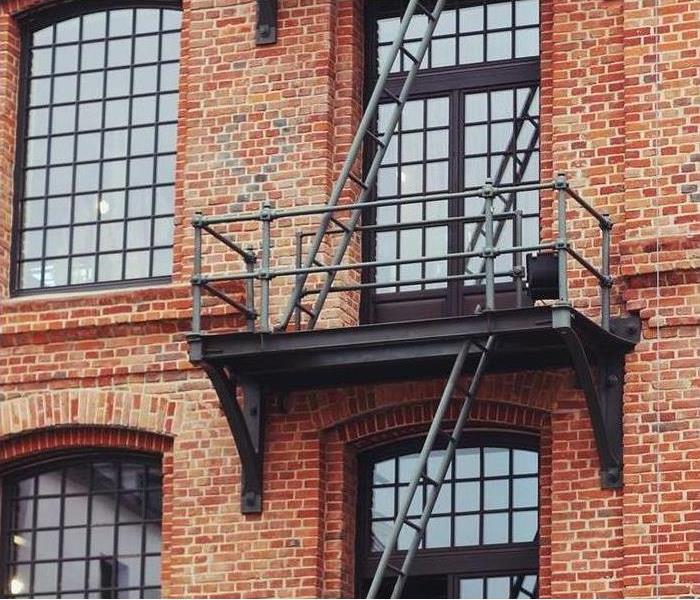 We are available for emergency restoration services 24 hours a day, seven days a week.
We are available for emergency restoration services 24 hours a day, seven days a week.
Every year in the United States, more than 350,000 house fires happen, adding up to more than $5.5 billion in property damage. Beyond the financial loss, these fires also lead to nearly 3,000 deaths and another 10,000 injuries.
The best defense for your family against a fire is to prepare in advance. That’s why it’s important for every person to know how to prevent fires and how to respond if one occurs.
Start teaching your kids basic fire safety guidelines when they’re young. Let’s also take a look at three other fire safety practices you can practice as a family:
Watch Out for Fire Hazards
Go through your home. You might be surprised how many fire hazards you spot! Take some time and go through every room and your outdoor space to uncover any hazards.
- Ensure your appliances are in good shape.
- Check that electrical cords are in workable condition.
- Do not overload outlets and/or extension cords.
- Check to make sure you are using the correct wattage of lightbulbs.
- Double-check that electrical wiring is not covered up by rugs or carpet.
Creating Your Fire Plan
In the event of a fire, every person in the family needs to know what to do—including how to get out of the house and where to go once they’re out.
But don’t just create a plan and not have practice drills. After all, as the saying goes, “practice makes perfect.” Regular practice of what to do makes you more likely to remember the steps if an actual fire occurs.
Practice Kitchen Fire Safety
Cooking is the biggest single cause of home fires. That’s why it’s important to be especially careful in the kitchen.
Anyone who’s cooking needs to familiarize themselves with basic cooking safety:
- Never cook when tired or unable to pay attention.
- Do not leave kids and teens alone when they cook.
- Always keep a lid at hand when cooking on the stove in case of a grease fire. If a small grease fire occurs, use the lid to smother the fire.
- If a fire occurs in the oven, turn it off and keep the door closed.
- Leave the room and close the door if a kitchen fire occurs and begins to spread.
If your family has experienced a fire and needs help restoring your home, we can help! Give us a call to learn about our fire restoration services and what we can do for you.
Do's & Don'ts for Fire in Your Home
5/1/2019 (Permalink)
SERVPRO of Western Essex County are devoted to keeping your family safe in case of an unexpected fire. Please review these tips to better prepare yourself for any future disasters:
DO:
-To prevent soot particles from being embedded into carpet, try to limit the movement around your home. This will avoid tracking. Also, keep your hands clean as you can further soil upholstery, walls and woodwork.
-Empty your freezer and fridge. Keep doors open to prevent odor.
-Wipe soot from metal kitchen and bathroom faucets, trim and appliances.
-Pour RV antifreeze in sinks, toilet bowls, and tubs, to avoid freezing pipes in case heat is off during the winter.
-Change your old HVAC filter, and leave it off until a professional can check the system
-To prevent soot from getting in or out of the HVAC system, tape your air registers with double layers of cheesecloth
DON’T:
-Do not attempt to wash any walls or painted surfaces, or shampoo carpets/rugs without contacting SERVPRO of Central Union County
-Do not clean any electrical appliances as it may have been close to fire
-Ceiling fixture wiring may be wet and damaged, so avoid turning them on. It may cause electrical shock
Call SERVPRO of Western Essex County For your residential or commercial needs. 866-361-3400
What to Do Before Fire Restoration Help Arrives
4/11/2019 (Permalink)
Learning that you’ve been affected by a home fire is devastating. While it’s stressful regardless of the extent of the damages, the good news is that if you hire a professional, many of the damages can be mitigated through restoration.
Working with a professional has several benefits—they work with your homeowner’s insurance company on your behalf, and they will also be able to salvage more items in the cleanup. However, as you’re waiting for help to arrive, it’s natural to want to do what you can to get started.
While some things should always be left to the professionals, a few things are safe for most people to do while they wait. If you decide you’d like to start on fire restoration ASAP, here are three things you can safely do:
Laundry
Getting started on laundry right away is the best way to help the cleanup process. Most things will have to be washed several times, so washing any clothing, bedding or other machine-washable materials with an alkaline cleaner or vinegar solution is a great place to start. Delicate fabrics, upholstery and curtains should be left to professional care.
<h3ventilation">Increased Ventilation
If weather allows, opening windows and doors will help reduce the smoky smell—be sure to let them remain open as long as possible. While the restoration team will bring industrial-grade equipment to aid this process once they arrive, this is a small step you can take toward helping the process along.
<h3cleaning">Preliminary Cleaning
Non-porous surfaces such as tile and countertops can benefit from a scrub with soap and water to cut through the initial layers of grime. Using a mild dish soap or alkaline cleaner is safe, but let the professionals handle the usage of anything more heavy-duty. Cleaning improperly can result in more severe and possibly permanent damage to your surfaces, so anything you’re unsure about should be left to the pros.
SERVPRO's a team of trained professionals can help your life get back to normal and get the cleanup done quickly in the event of a home fire.
Fire Damage Specialists
8/29/2018 (Permalink)
Fire damage to your home can be a traumatic experience for any homeowner. Apart from the damage due to heat, fire can cause significant damage to your property and belongings due to smoke and soot. The smoke particles can coat walls, ceilings, and almost any surface and cause permanent damage if not cleaned quickly and efficiently.
The particles in the smoke contain unburned carbon that can be very difficult to remove after a fire to your Western Essex home. Not all soot particles are alike, and it takes a multi-step process to eliminate them. It is a job for the professionals who have years of training and expertise in fire damage restoration.
We’re Fire and Water Damage Specialists
As fire and water restoration specialists, we have the training, experience and specialized equipment necessary to restore your home or business. We are committed to providing superior service while restoring your property back to pre-fire condition.
- Fire & Smoke Restoration Technician
- Odor Control Technician
- Upholstery & Fabric Cleaning Technician
- Water Damage Restoration Technician
Call SERVPRO of Western Essex County (973) 994-1640
Fire Cleanup
8/8/2018 (Permalink)
If your home has a smoke/soot issue, call SERVPRO of Western Essex County today at 973-994-1640. Don't attempt to clean anything as it could make it an irreversible event.
After any fire damage situation, your primary focus should be safety first:
- Is it safe to stay in the house?
- Electrical and "slip and fall" hazards are some of the most prevalent concerns.
- Only do activities that are safe for you to perform.
- Wet materials can be VERY heavy. Be careful!
Have Smoke or Fire Damage? Call (973) 994-1640
What to Do After a Fire
- Limit movement in the home to prevent soot particles from being embedded into upholstery and carpets.
- Keep hands clean so as not to further soil upholstery, walls and woodwork.
- Place clean towels or old linens on rugs, upholstery and carpet traffic areas.
- If electricity is off, empty freezer and refrigerator and prop doors open.
- Clean and protect chrome with light coating of petroleum jelly or oil.
- Wash houseplants on both sides of leaves.
- Change HVAC filter.
What NOT to Do After a Fire
- Don't attempt to wash any walls or painted surfaces or shampoo carpet or upholstery without contacting us.
- Don't attempt to clean any electrical appliances that may have been close to fire, heat or water without consulting an authorized repair service.
- Don't use any canned or packaged food or beverages that may have been stored near the fire, heat or water.
- Don't turn on ceiling fixtures if ceiling is wet. The wiring may be damaged.
- Don't send garments to an ordinary dry cleaner. Improper cleaning
- may set smoke odor
Help Your Fire Department Help you
7/31/2018 (Permalink)
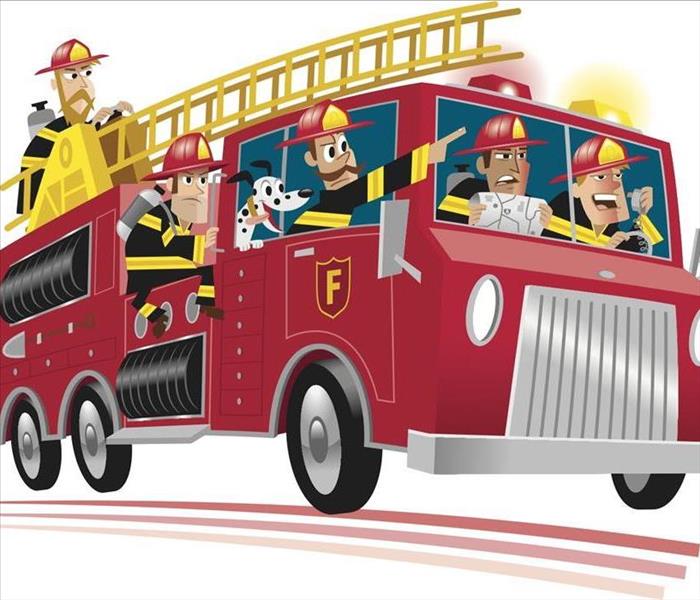
- Always practice fire drills- Fire drills shouldn’t stop at your job or at school. They are important for families too. Have an escape plan and review emergency exists in your home. Your family should practice crawling low on hands and knees through the emergency exists.
- Make sure street numbers are visible – Fire fighters and first responders need to find where you live quickly. House numbers should be at least four inches tall, visible from the street. Remember that fire fighters sit higher in their vehicles than drivers of regular automobiles.
- Inspect your extension cords- Extension cords can take a good beating overtime, and damaged ones pose a fire hazard. Make sure to inspect your extension cords and discard and that get hot with use. If their cord or outlet strip looks damaged, throw it away immediately.
- Prevent false alarms- False alarms can cost fire fighters valuable time and money. Make sure your fire alarm system is installed by a licensed professional. It is important to test your fire alarm system monthly, and keep it clean of dust and debris.
- Use proper fuel for your fireplace- Never burn trash or paper in the fireplace. Tiny particles of ignited paper can float up your chimney then onto the roof and into the yard, posing a severe fire risk.
- Get the right extinguisher and learn how to use it- Fire fighters recommend a 2-1/2 pound class ABC multipurpose dry chemical extinguisher for your home. This model can be used to put out many types of fire, including those involving wood, paper, plastics, liquids, electric appliances, or outlets. Review the operating instructions for each fire extinguisher you have. Pull the pin, aim at the base of the fire, squeeze and hold down the handle, and sweep from side to side and front to back.
Source: www.bobvila.com
What You Need to Know About Fire Extinguishers
7/31/2018 (Permalink)
One important fact that homeowners need to know about fire extinguishers is that they do in fact expire. Fire extinguishers last between 5 and 15 years but they all ultimately expire and become ineffective, no matter what fire-fighting substance they contain. Household fire extinguishers are typically filled with dry chemicals (carbon dioxide or halon) and can lose their charge over time. Extinguishers with compressed gas can leak contents slowly as their seals weaken, while those with ammonium phosphate will solidify over the years, becoming unusable.
Some units can be professionally recharged. Check the expiration of the original charge, read on to get a handle on the age and effectiveness of your fire extinguisher. Locate the paper tag on the fire extinguisher. It may not imply an expiration date, but if the oldest date on that was more than 10 years ago, it may already have lost its ability to fight flames.
Additionally, homeowners should inspect the pressure gauge at the top. If the needle is within the green area, it should still work fine. A needle in the red or white area indicates that it requires service. Older models usually have no gauge, which means it would be wise to take it to a professional for testing and, if necessary (and possible), recharging. A professional recharge typically runs between $15 and $20, a bargain compared to a new extinguisher, which will likely cost $100 to $200.
Store a fire extinguisher in a clean, indoor location can help extend its life. Exposure to sun, UV radiation, wind, or rain can cause corrosion, rust, and deterioration. Excessively dusty or dirty environments can hamper the device’s ability to function properly. If the canister is dented or bruised, or if the tamper seal and pin are missing, there’s a possibility that it might explode unprompted. Examine the entire unit and if it’s not in good shape, properly dispose of it without delay.
Common House Fire Hazards you may not be Aware of
5/16/2018 (Permalink)
Many people do not realize it but there are numerous bad habits we tend to ignore that may spark a fire in our homes. Consider the following hazards:
- Dirty rags- Sure, we’re inclined to pile up rags in a corner, but be aware! Oil soaked rags thrown and left unattended can potentially oxidized, spontaneously combusting, causing a house fire. Let rags dry flat outside or if disposing, use a metal can filled with water and a tight lid.
- Improper use of electric blankets- Yes, even a cozy blanket can go wrong. Never let your pet to snuggle on top, and make sure not to pile extra covers over the electric blanket. Excessive heat build-up can trigger a fire. To stay on the side, keep your blanket on the lowest setting and don’t forget to turn it off when not in use.
- Home Appliances Recalls- A significant amount of home appliances caused house fires in the past decade, some being from defective appliances. To ensure that you are on top of your home appliances, register your appliances with the manufacturers or recalls.gov to see if any of your models are on the list.
- Dryer Lint- Aside from cleaning your lint screen for more drying efficiency, did you know that lint can become flammable? Be very consistent with cleaning out lint from your dryer vent and exhaust duct.
- Excess amount of extension cords- Connecting a large amount of cords for an extensive amount of time can cause a short circuit and ignite a fire. Extension cords are not permanent solutions for a lack of electrical outlets.
- Oven Range hoods- While stoves can be a very common source for kitchen fires, range hoods present potential fire hazards as well. Grease builds up inside the vent hood filter and can potentially drip onto the stove, igniting a probable fire.
Source: www.bobvila.com
Fire in Kitchens
4/12/2018 (Permalink)
Cooking fires are the number one cause of home fires and home fire injuries. Home fires are more likely to start in the kitchen than any other room in your home. Unattended cooking causes nearly 90 percent of all kitchen fires. Here are some tips to prevent Kitchen fires.
- Never leave cooking food unattended! Fires can happen spontaneously. Cooking food should always be monitored. Make sure if you leave the room, to turn off the stove.
- Avoid any loose clothing. Baggy t-shirts or dangling sleeves can potentially catch on fire while around a stove.
- Always watch your kids! For parents, we want to keep our kids safe and sound from any fires. Try to avoid having your child(ren) around cooking areas. At least 3 feet away from the stove is ideal to insure their safety.
- Try to keep anything that can catch on fire away from your stove stop. This can include oven mitts, wooden utensils, paper or plastic bags, and towels or curtains. Materials like such can generate heat.
- Consider purchasing a fire extinguisher to keep in hands reach in your kitchen.
Prevent Fires in the Workplace
8/29/2017 (Permalink)
A fire can happen anywhere and anytime. Here are some tips on things we can do to help prevent a fire in the common workplace.
Accessibility
Always ensure accessibility to electrical control panels. Material or equipment stored in front of the panels would hinder the shutdown of power in an emergency. Also, never block sprinklers, firefighting equipment or emergency exits and observe clearances when stacking materials.
Good Housekeeping
Clutter not only provides fuel for fires, but also prevents access to exits and emergency equipment. Keep your workplace as clutter-free as possible.
Proper Waste Disposal
Discard fire hazards like oily rags by placing them in a covered metal container and emptying it on a regular basis.
Maintenance
Make sure the machines in your workplace are properly maintained to prevent overheating and friction sparks.
Report Electrical Hazards
Unless you are qualified and authorized, you should never attempt electrical repairs. Faulty wiring and malfunctioning electrical equipment are key contributors to workplace fires.
Safe Chemical Use & Storage
Always read the label and the Material Safety Data Sheet to assess flammability and other fire hazards of a substance. When using and storing chemical materials, always do so in an area with adequate ventilation.
Precautions In Explosive Atmospheres
Follow all recommended and required precautions to prevent ignition in potentially explosive atmospheres, such as those containing flammable liquid vapors or fine particles. These precautions include non-sparking tools and proper static electricity control.
Maximum Building Security
To help prevent arson fires, always lock up as instructed, report suspicious persons or behavior and never leave combustible garbage outside near your building..
Smoke Areas
Always ensure that there is a smoke area available and that all workers who smoke on the job are using it. Proper extinguishing of smoking materials should always be enforced.
Fully Charged Fire Extinguishers
Check fire extinguishers often by looking at the gauges and making sure they're fully charged and ready for use. If they're not fully charged or if the attached tag indicates that the last inspection occurred more than a month ago, call for maintenance. Also, encourage all workers to learn how to use a fire extinguisher.
Emergency Numbers
Emergency phone numbers, as well as your company address, should be posted by the phone station for quick access.
11.5 OSHA Guidelines
Adherence to OSHA's fire safety guidelines is crucial for fire prevention. Read through these regulations and make sure your workplace is in compliance.
Making sure your workers return home safely is our mission and passion. Take these 11.5 tips to your workplace and practice true fire safety, which begins before the fire even ignites.
If you have any questions or concerns you can always visit our site, and social media pages to learn more about our system services.
https://www.facebook.com/SERVPROwessex/
https://www.instagram.com/SERVPROwessex/
Sound The Alarm Save a Life
8/9/2017 (Permalink)
In the coming weeks, we will be reaching out to recruit 35,000 volunteers to install 100,000 free smoke alarms across the country as part of Sound the Alarm – a series of lifesaving home fire safety and smoke alarm installation events happening September 23 - October 15.
Sign up now to Sound the Alarm about home fires, and make a difference today!
I hope you’ll be a part of this important effort. Home fires disproportionately harm children and seniors, and most deaths occur in homes that lack working smoke alarms. That’s why the Red Cross started the Home Fire Campaign in 2014 – to reduce the number of deaths and injuries caused by fires in homes by 25 percent. Seven Americans die every day from fires in their homes. By signing up as a volunteer to Sound the Alarm this fall, you can help save those lives.
Did you know that 90 percent of the Red Cross’s humanitarian efforts are carried out by volunteers?
These volunteers are friends and neighbors who care about their community – people just like you. They are a diverse group, but they all share one thing: They know how deeply rewarding it can feel to make their town a safer place to live, and how delightful it can be to get to know their neighbors in the process.
Since we first launched the Home Fire Campaign in 2014, our volunteers have achieved so much: installing 941,916 smoke alarms, educating 884,007 youth about fire safety, and saving hundreds of lives.
Sound the Alarm is part of this ongoing Home Fire Campaign, and if you join us as one of those 35,000 volunteers this fall, we can bring the total number of free smoke alarms we’ve installed as part of our Home Fire Campaign since 2014 to one million!
Sign up now to find an installation event in your community and help save a life in the process! We’re counting on volunteers like you to step up, install more smoke alarms, educate their communities about fire safety, and have fun exploring new neighborhoods and getting to know one another.
The life you help save could be that of the neighbor down the street or your own family across town.
Thank you for everything you do – it really does make a difference.
Sincerely,
Lauri Rhinehart
VP, Humanitarian Services
American Red Cross
P.S. If you're unable to volunteer, you can still make a meaningful difference by fundraising for this cause or making a financial gift today.
How to Help Prevent House Fires
7/31/2017 (Permalink)
We have developed a list of the most common causes of fire-related losses as well as some things you can do to help prevent them.
Faulty Wiring and Outlets Are One of the Top Causes of House Fires.
- Check the electrical cords throughout your home for signs of fraying, and replace all frayed wires.
- Do not pinch or cover electrical cords with items such as rugs.
- Be aware of the capacity of your home's electrical system. Do not overload your circuits. If you have questions about your home's electrical system, you may want to consult a licensed electrician.
- Understand the difference between surge protectors and power strips—both allow you to plug in multiple electronic devices, but only the surge protector will help protect these devices from a power spike. Use surge protectors to protect valuable electronic devices, such as computers and televisions.
Carelessness in the Kitchen May Also Lead to a House Fire.
- Never leave your pots or pans unattended on your stove.
- Keep a kitchen fire extinguisher readily available and know how to use it.
- Keep your stove and oven clean. Built up food splatter or grease can later ignite when the stove or oven is turned on for cooking.
Clothes Dryers Are Another Common Source of House Fires.
- If you are installing your own dryer vent, follow the directions in the manufacturer’s installation instructions, using the recommended duct material. If you are unsure about how to properly install the vent, consider hiring a professional to do the installation.
- Clean out the dryer vent regularly.
- Clean out the lint filter after each load.
- Lint may also collect under and behind your dryer, so do not forget to clean these areas.
Alternative Heating Sources May Also Create a Fire Hazard.
- Avoid using an older space heater, as it may not have adequate safety features compared to newer units. When purchasing a new space heater, ensure it is UL Listed and pay attention to the safety features.
- Do not place a space heater near furniture, curtains or other objects that could easily catch fire.
- If you plan to install an alternative heating system, such as a wood or pellet stove, follow the manufacturer's instructions. If you are unsure about how to properly install the system, consider hiring a professional to do the installation.
- Before installing a wood or pellet stove, check to ensure it complies with the laws of your state and municipality.
Dirty Chimneys Also Pose a Fire Hazard.
- Have your chimney inspected annually by a Chimney Safety Institute of America (CSIA)-certified chimney sweep. Have a professional clean and repair the chimney as needed, especially before the cold months, when you will be using it frequently.
- Use seasoned wood only. Never burn green or damp wood.
- Never burn cardboard boxes, wrapping paper, trash or trees in your fireplace—these can all spark chimney fires.
Statistics on Main Causes of Fires
7/31/2017 (Permalink)
Unfortunately we all know for a fact that fires happen. As much precaution as we take to prevent them, they happen! So then what are the main causes of fires starting? The U.S. Fire Administration estimated that the leading reported causes of fires in non-residential buildings for 2013 was due to cooking materials (29.3%), intentional (9.7%), and carelessness (9.2%). However, The National Fire Protection Association (NFPA) broke down the statistics on the main causes of fire in healthcare, educational, and commercial properties.
Healthcare
In the healthcare arena, the U.S. fire departments responded to an estimated average of 6,240 structure fires during 2006-2010.
- 61% of fires were due to cooking equipment
- 7% of fires were due to clothing equipment
- 6% of fires were started intentionally
While cooking equipment seemed to have been the leading cause of fires, nursing homes were more likely to have fires involving clothes washer & dryer. And facilities providing care of those with developmental disabilities, mental illness or substance abuse had more fires that were intentionally set.
Education
In the educational arena, during 2007-2011 an estimated average of 4,060 structure fires per year were reported in educational facilities. And an estimated 700 structure fires per year were reported in college classrooms and adult education centers.
- 13% of fires began in a kitchen or cooking area
- 49% of fires were started intentionally
- 32% occurred in the lavatory or bathroom
Most fires in educational properties occurred in nursery, elementary, middle, or high schools.
Commercial
In the commercial arena, an estimated average of 3,700 fires in hotels were reported to the U.S. fire departments during 2006-2010. And the U.S. fire departments responded to an estimated average of 3,340 fires in offices during 2007-2011.
In Hotels:
- 45% of fires were due to cooking equipment
- 10% of fires were due to smoking material
- 9% of fires were due to heating equipment
Nearly three-quarters of fires in hotels didn’t spread beyond their origin. However, fires that began in a bedroom were responsible for 31% of civilian injuries and 72% of civilian deaths. Smoking materials were the cause of the fire in 79% of civilian deaths.
In Office Buildings:
- 29% of fires were due to cooking equipment
- 12% of fires were due to electrical and wiring equipment
- 11% of fires were due to heating equipment
Although cooking equipment was the leading cause of office fires, it only accounted for just 6% of the direct property damage. Electrical and lighting equipment caused 15% of direct property damage, while fires that were intentionally set caused 20% of direct property damage.
All in all cooking and electrical equipment, carelessness as well as fires set intentionally, are the main causes of fire. So what can you do to prevent fires from happening? Be cautious when using electricity or any kind of heating equipment and make sure your passive fire protection system (fire/smoke dampers, fire doors, and firestop) are inspected and tested to help ensure that your building as well as its occupants are safe in case of a fire.
Business Safety
7/31/2017 (Permalink)
Fire Safety Tips for the Workplace
No matter type of business you conduct at your workplace, fire safety should always be a main concern. Here are a few fire safety tips you can distribute to your staff.
Fire Prevention
- Keep your work area free of waste paper, trash and other items that can easily catch fire.
- Check on your electrical cords. If a cord is damaged in any way, replace it. Try not to lay cords in places where they can be stepped on, as this will contribute to deterioration of the protective outside coating.
- Don't overload your circuits.
- Turn off electrical appliances at the end of each day.
- Keep heat producing equipment away from anything that might burn. This includes copiers, coffee makers, computers, etc.
In the Event of a Fire
- Upon finding a fire, call 911 immediately and don't hand up with the emergency responder until told to do so.
- Close doors when exiting to help limit the spread of smoke and fire throughout the building.
- Never use elevators during an evacuation.
- Follow the escape plan and meet at a per-determined place outside of your building and away from danger. Conduct a headcount to ensure all of your staff has evacuated.
The best way to ensure the safety of your staff is through fire prevention and preparation. Talk with your staff about fire safety in the workplace today.
What to do After a Fire
7/31/2017 (Permalink)
Now that the fire is out, there are a few things you need to know. Here is a check list to follow:
Step 1 - Securing the site
- Protect the fire site from any further damage by weather, theft or vandalism. Do not leave the site unsecured.
- If you are the owner it is your responsibility to see that openings are covered against rain and entry. Make sure outside doors to the property can be locked and secured. The Fire Department will help secure the premises until responsibility can be handed over to the tenant or insurance company.
- If you are the tenant contact your real estate agent or landlord and inform them of the fire. If you cannot contact them and you need professional assistance in boarding the premises, a general contractor for or fire damage restoration firm can help. Check your telephone directory.
- If you plan to leave the site, try to remove any valuable remaining in the building.
- Contact your own insurance agent to report the loss.
Step 2- Cautions
- Household wiring which may have been water damaged should be checked by a licensed electrician before power is turned back on.
- Check for structural damage caused by the fire. Roofs and floors may be weakened. The local Council's Building Inspector may be able to help.
- Food, drink and medicines exposed to heat, smoke or soot may be discarded in the appropriate manner.
- Refrigerators and freezers left unopened will hold their temperature for a short time. However do not attempt to refreeze thawed items.
- The Fire Department will call for the services of the local gas, fuel and electricity suppliers to disconnect services before they leave the site.
- If a utility (gas, electricity or water) is disconnected, it is your responsibility to have the services checked and reconnected by a licensed trade person. Do not attempt to reconnect the service yourself.
- Start collecting receipts for any money you spend. These are important because you can use them to show the insurance company what money you have spent relating to your fire loss and also verifying losses claimed.
Step 3 - Insurance Claims
- Make personal contact with the insurance claims manager.
- Advise the claims manager of loss or damage and give him, or her, a forwarding address and telephone number if the circumstances have forced you to leave the damaged fire building.
- The sooner the insurance company is alerted, the quicker the insurance claim can be processed, as the company has to alert the insurance adjuster to carry out the inspection.
- Try to form an inventory, as soon as possible, of household items either inside or outside the buildings which have been damaged by fire. The inventory of damaged items will further speed the claim when the loss adjuster makes contact. Do not throw away any damaged goods until after the inventory is made by the insurance adjuster.
Step 4 - Leaving your home
- If you have to leave your home because the fire has left it unsafe, contact the local police. They can keep an eye on the property in your absence.
- Check with your insurance company to find out whether you are entitled to stay in hotel as part of a temporary housing clause in your policy, or how soon you might get an advance on your eventual insurance claim settlement.
- Provided it is safe to do so, try to locate the following to take with you:
- Identification
- Vital medicines, such as blood pressure regulating drugs or insulin.
- Eyeglasses, hearing aids, prosthetic devices or personal aids.
- Valuables such as credit cards, check-books, insurance policies, savings account books, money and jewelry.
Notify these people of your new address
- Your employer.
- Family and friends.
- Your children's schools.
- Your Post Office. Have them either hold or forward your mail, depending on the length of time you expect to be relocated.
- Delivery services like newspapers and milk.
- Telecom and the suppliers of gas, electricity and water.
contact:
SERVPRO of Western Essex County at 973-994-1640
We will help to get your life in order after this catastrophic event.
Fire Prevention & Safety Tips; American Red Cross
8/28/2015 (Permalink)
Did you know that if a fire starts in your home, you may have just two minutes to escape?
The most effective way to protect yourself and your home from fire is to identify and remove fire hazards. Sixty percent of house fire deaths occur in homes with no working smoke alarms. During a home fire, working smoke alarms and a fire escape plan that has been practiced regularly can save lives.






 24/7 Emergency Service
24/7 Emergency Service




















